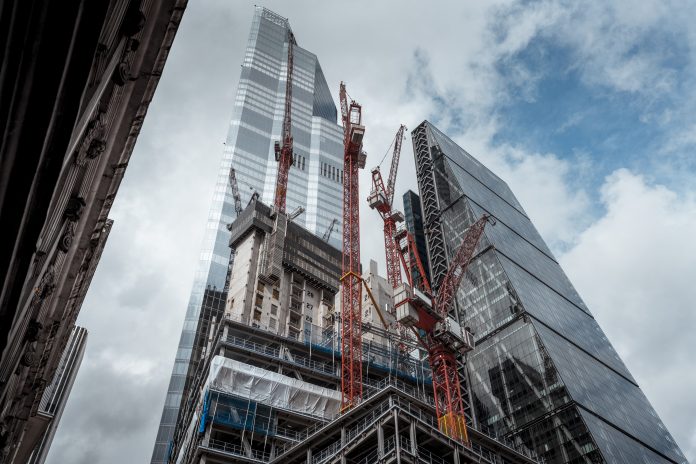There is an urgent need to accelerate the pace at which we are retrofitting commercial buildings in the UK
70% of the UK’s non-residential building stock was constructed before 2000 and 80% of the buildings that will be occupied in 2050 are already in existence.
As a result, to meet net zero targets, the energy performance of these buildings must be significantly improved.
Focus needs to turn to retrofitting our existing building stock over demolition and building new properties.
By prioritising this, the chances of decarbonising the built environment, which is currently responsible for 25% of UK greenhouse gas emissions, will increase. At the current rate, net zero targets seem out of reach.
Embodied carbon is also an important consideration, as this is significantly higher when demolishing and rebuilding a building than when retrofitting it.
Significant levels of locked in carbon are wasted when a building is knocked down and carbon-intensive materials are then required to rebuild it.
Embodied carbon is expected to account for around 50% of built environment emissions by 2035 so building owners should always consider if a building can be retrofitted or repurposed before deciding to demolish it.
Too often, embodied carbon is overlooked but reducing it will play a vital role in meeting targets.
What role can building technology play?
According to JLL, retrofitting rates need to triple to meet the goals outlined in the Paris Agreement. To increase the pace of retrofitting to this level, technology such as digital twins will need to be utilised.
Building owners may have previously been discouraged from retrofit due to the belief that it is an uncertain investment that might not produce tangible energy and cost savings.
However, technological advancements in the built environment space have removed the need for assumptions and enabled accurate performance measurement.
One such advancement is the creation of digital twins, digital models of buildings using physics-based simulations, real data, artificial intelligence, and machine learning to respond as their real-word counterpart would.
This technology can be utilised to inform retrofitting decisions by enabling the virtual testing of different design options.
Building owners can then be assured that costly mistakes won’t be made and receive accurate predictions on return of investment.
The data can be used to determine the most suitable level of retrofit, providing reassurance that the optimum solution has been selected for the future of the building.
In addition, these improvements can enhance occupant comfort and wellbeing.
Results such as improved insulation, better ventilation systems and effective use of natural light can help to create healthier indoor environments for occupants and reduce health issues associated with poor air quality and inadequate thermal conditions.

How does the digital twin work?
Firstly, data is collected from multiple sources within the building or buildings in question. This enables accurate analysis of performance, including where energy is being consumed, wasted, and can be saved.
Measures to reduce consumption and wastage can then be tested using the digital twin to determine which would be most impactful when made to the real building. This varies from very minor improvements to full scale retrofits.
Some of the improvements that might be recommended as a result of the testing include new windows, HVAC system upgrades, better insulation, or the implementation of renewable energy sources.
When the most suitable level of retrofit and building upgrades are determined, these can then be implemented to improve the building performance, reduce operations costs, and lower the overall impact of the building on the environment.
Retrofitting Dublin’s social housing
We can see an example of how this technology can inform retrofitting decisions through IES’s work with Dublin City Council.
As part of the collaborative project, digital twins were created of three social housing residential blocks on Lower Dominick Street in Dublin.
The aim of this was to determine which of four strategies, from shallow retrofit to demolition and rebuild, would be most effective to regenerate the buildings.
When testing the strategies, it was important to assess the full carbon impact and consider both operational and embodied energy.
The options were also tested over three different time periods and aligned with the council’s climate targets for 2030, 2050 and beyond.
To determine the most impactful option, the main sources of energy consumption were identified via data calibration from existing energy bills.
Analysis showed that the best renovation over a 60-year life period would be deep retrofit.
Each residential block would be able to achieve an 85% reduction in cumulative emissions once this level of retrofit is complete.
Utilising the technology to carry out the study enables the council to make data-driven decisions, ensure budgets are spent wisely and inform the approach to regenerate similar buildings across Dublin in the future. Furthermore, it enables them to meet targets imposed by the government and highlights the importance of retrofitting when it comes to reducing emissions.
Retrofitting commercial buildings in London
Retrofitting has an essential role to play if the UK is to meet net zero goals. The existing building stock must take priority, and in most scenarios, it is more cost-effective to retrofit an existing building that to construct a new, energy-efficient one.
Encouragingly, the introduction of the Minimum Energy Efficiency Standard (MEES) and other regulation seems to have encouraged the retrofitting rate to pick up.
For example, new research by Deloitte shows that London is seeing a record volume of office refurbishment schemes.
Retrofitting provides energy cost savings
Whilst bills remain high, retrofitting also unlocks valuable energy and operational cost savings over the building’s lifetime.
Effective retrofitting can help to retain heat in winter and ensure optimum ventilation in summer months, reducing bills and enhancing occupant comfort.
To determine the most impactful building improvements and speed up the retrofitting revolution to the required level, use of the technology available is vital.
There is no longer a need for assumptions or guesswork and building owners can be assured that the right level of retrofit has been implemented for their building, preventing costly mistakes further down the line.
As the 2050 target looms closer and building regulations around energy efficiency ramp up, technology can identify a path to net zero, helping building owners to meet required standards and reduce the burden of their building on the environment.
Ian Pyburn
Business development manager














